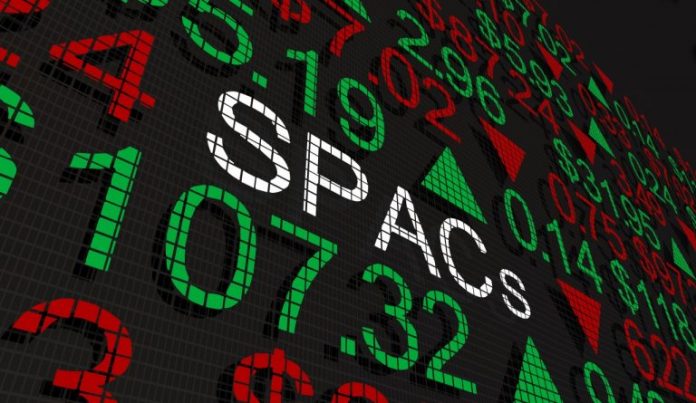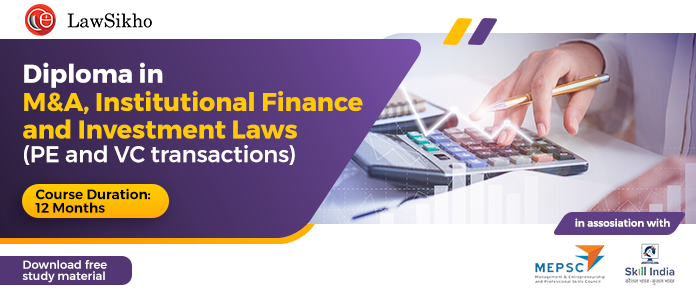This article has been written by Naveen, pursuing a Diploma in M&A, Institutional Finance and Investment Laws (PE and VC transactions) from LawSikho.
Table of Contents
Introduction to SPAC
Special Purpose Acquisition Companies (SPACs) have emerged as one of the popular methods to raise investment capital through IPO in 2021. SPACs are “blank cheque” companies with no commercial activity of their own. They are usually run by institutional investors and venture capital firms. The primary source of their funds is the amount that they raised through an Initial Public Offering (IPO). They raise such capital through institutional and retail investors and the capital goes into a trust. The trust will manage with the money and then identify a target for acquisition. The target companies that they intend to acquire are usually not publicized during the IPO process.
They utilize a process similar to a reverse merger wherein post listing, they acquire another company with commercial operations. Such target companies are ones that are usually looking forward to a listing but are unable to do so due to lack of adequate capital or other regulatory requirements.
What benefits do SPAC companies derive from the process?
SPACs are usually founded by a group of “founders” who may be experienced business executives who rely on their expertise and experience in the sector. They scout for profitable companies to merge with.
Why do target companies go for SPACs?
The process of a listing through a SPAC is much simpler than an IPO process. The capital requirements and regulatory approvals are substantially higher compared to an acquisition by a SPAC.
Life cycle of a SPAC
- IPO process- A SPAC company goes public following the same set of regulations that any other company has to go through.
- Finding the ideal transaction- The SPAC looks out for companies which fits its stated criteria and one which makes a good public company.
- Negotiation of a transaction structure- This includes the valuation of the target and the percentage of the target company sold to the SPAC.
- Approval by the SPAC’s shareholders- The target company pitches the transaction structure and viability of the target to the shareholders. The shareholders are required to approve such a transaction.
- De-SPAC- This stage involves the formal merger of the SPAC shell company into the target company. The target company then trades as a normal publicly traded company on the exchange.
Lifetime of a SPAC
It is to be noted that these SPACs cannot go on for more than a time period without acquiring another company. The time duration varies according to the jurisdiction. If the acquisition does not take place, the trust will return the money to the investors and file for liquidation.
Differences between IPO and SPAC
IPO is the first public sale of the shares of a company. The operations of a company are what determines the value of the company, into which the shareholders invest. There would also not be any fundamental changes in management. Whereas, in a SPAC, the shareholders buy into the potential of the founders to find a good acquisition given their background and expertise. The shareholders are generally more speculative than in an IPO process.
Valuations of target companies in the SPAC process
SPACs have more ability to share forward-looking information than an IPO. This can attract different shareholders and different valuations. This is evident in the trend that technology companies utilise SPACs as they are able to demonstrate more futuristic information than a usual IPO candidate.
The valuation in a SPAC is done through negotiations between the SPAC founders and the target company and the shareholder approval of the same. On the other hand, in an IPO, the market decides the pricing of the company through the underwriters. The underwriters go on to pitch the company to institutional investors. This process is tedious and uncertain because many of the institutional investors have a style of investment and are sector specific. Thus, there is more scope for a better valuation in a SPAC than an IPO.
Investor interest post acquisition
SPAC investors can either swap their shares for those of the merged firm or redeem their SPAC shares to obtain their initial investment back once an acquisition is completed.
Resurgence of popularity
SPACs have been in existence since the past 30 years. The market today due to the pandemic provides a lucrative platform for SPACs. It brought with it immense volatility in the market which made it unviable for companies desiring a listing to choose the route. This also made the availability of capital through other sources such as Venture Capital Funds as they turned to be more selective in where they were investing given the uncertainty in the financial markets.
Why should food and beverage companies consider the SPAC process?
Going public for a company can provide it access to further capital, better brand value and diversification of shareholders. Apart from these benefits that the target enjoys after de-SPACing, prior to it the founders of the SPAC can bring in major contributions to the company like brand building and manufacturing capabilities, which may be lacking otherwise. However, there are downsides to being a publicly listed company. Food and beverage companies should opt this route after determining their capital requirements, capital flow and their current brand value.
Process to be followed for companies envisioning a SPAC process
After the company decides to go public through a SPAC process, the company needs to consult relevant advisors to understand:
- Legal requirements- To understand the regulatory hurdles in a SPAC process for the company. This includes understanding and analysing the manpower required for post-SPAC compliance and disclosures.
- Accounting requirements- To understand the current status of the company and how far it is from being ready to enter the public market.
- Financial advisory requirements- to understand the ongoing cost and the cost of going public as it adds to the overhead cost of the company. They also help the company understand the trade-off that the company makes while going public, how much it can cash out during the process and compare it with a traditional IPO process.
Regulatory challenges to SPACs
-
Companies Act
Since the announcement of demonetization in November 2016, the government has been cracking down on suspicious shell firms, and there has been a rush to define them because they are not currently specified under the Companies Act. In March 2018, a Parliamentary committee requested that the government define the phrase “shell company” in the Company Act to “avoid legal ambiguity and pre-empt avoidable litigations”.
The registrar can remove a company’s name from the register of companies if the company “failed to commence its business within one year of its incorporation,” according to Section 248 of the Company’s Act 2013. A SPAC’s average acquisition time is 18 to 24 months. In order to maximise shareholder wealth, the sponsors require this time to pick the ideal objective. As a result, this phrase poses a significant challenge for successful SPAC implementation in India.
-
SEBI Regulations
Section 26 of the SEBI (Issue of Capital and Disclosure Requirements) Regulations, 2009 (as amended in August 2017), establishes the minimum eligibility requirements for a public offer. The issuer must meet the following criteria:
- Net tangible assets of at least INR 3 crore in each of the preceding three years.
- Minimum average consolidated pre-tax operating profit of INR 15 crore during any three of the last five years.
- Net worth of at least INR 1 crore in each of the last three years.
It’s clear that SPACs can’t fulfil any of these requirements as they don’t have any non-monetary tangible assets or operational profits. Furthermore, even if the founders inject cash, most SPACs will not be able to wait three years to be listed.
-
Stock Exchange Regulations
The Stock exchanges in India- BSE and NSE require companies desiring a listing to be compliant with SEBI regulations. SPACs are also disqualified for listing since the NSE needs positive operational cash accruals (Earnings before Depreciation and Tax) for the previous two years.
However, it has been a lucrative method to get a listing in other markets such as the USA. There have been recent amendments to make the market more friendly to SPACs in the USA. Indian companies can prefer a route to be listed on such exchanges given the unviable situation in India. However, the SEBI has recently constituted a committee to look into the viability for regulating SPACs and the hurdles that it currently faces. It is a welcome move for the market players.
Major SPAC involved listings of food and beverage companies
Food is necessary for human survival, yet there is considerable impact that the COVID-19 pandemic has had on the food supply chain. However, the pandemic and the disruption of the supply chain has upheld the importance of such companies which makes it attractive to institutional and retail investors in the public market. It is evident that they view the sector as an essential sector immune to the volatility with a constant capital flow. It is therefore a ripe time for food and beverage companies to go public.
However, as discussed previously, the market has been subject to volatility and therefore, an IPO route may not be attractive to gain a suitable valuation. The SPAC model however allows for a better valuation and brand presence given the added reputation that the founders has accumulated. It also provides a speculative and forward looking shareholder group for the company which enables it to push more sustainable products.
Grofers, a popular food delivery company has been considering the SPAC route to list itself on the US exchanges. It is backed by various private equity and venture capital funds including SoftBank which has been repeatedly involved with the SPAC process to take its portfolio companies public.
Similarly, Siddhi Capital in the US has also filed for a $200 million IPO of its SPAC company Siddhi Acquisition to target food and beverage companies. There have been various other SPACs created in the sector which are all valued over $200 million such as Fast Acquisition II, USHG Acquisition Corp. whose founders include various highly regarded restaurateurs and big names in the hospitality sector, Bite Acquisition Corp. where the founders included CEOs of various leading restaurant groups, Do It Again where the founders included former executives of Sonic Drive-Ins, Sizzle, Starboard Acquisition where the founders included former Dunkin’ Brands CEO Nigel Travis. Utz went public in the USA using a SPAC deal. Indoor greenhouse operator AppHavest recently followed suit, following biltong maker Stryve Foods which announced a deal with a SPAC.
Conclusion
It is this very evident that SPAC has emerged as one of the leading methods for ensuring that a company can go public without going through the hassles of an IPO and de-SPAC into enjoying the benefits of a public listing. The food and beverage industry players must capitalise on the goodwill generated by their participation in the supply chain during the pandemic and tread the SPAC route for a listing.
References
- https://www.foodbusinessnews.net/articles/17739-blank-check-investors-eyeing-food-and-beverage-opportunities
- https://www.fooddive.com/news/biltong-maker-stryve-foods-going-public-in-170m-spac-deal/594149/
- https://spacfeed.com/spac-siddhi-acquisition-files-for-a-200-million-ipo-targeting-the-food-and-beverage-industry
- https://www.fooddive.com/news/appharvest-to-go-public-through-merger-valuing-company-at-1b/586046/
- https://www.restaurantbusinessonline.com/financing/here-are-all-restaurant-spacs-right-now
- https://www.fooddive.com/news/report-utz-heading-toward-1b-deal/577744/
- https://mnacritique.mergersindia.com/regulatory-challenges-special-purpose-acquisition-company-india/#:~:text=Successful%20SPAC%20listings%20over%20the,development%20of%20SPACs%20in%20India
LawSikho has created a telegram group for exchanging legal knowledge, referrals and various opportunities. You can click on this link and join:
 Serato DJ Crack 2025Serato DJ PRO Crack
Serato DJ Crack 2025Serato DJ PRO Crack











 Allow notifications
Allow notifications



